
Danielle Lirette

Audio By Carbonatix
On the 2200 block of Welton Street, an enormous thirteen-story apartment building is emerging from what was until recently a decrepit surface parking lot. Once finished, it will bring 358 units to Five Points, but barely make a dent in demand for housing in the area – and reflective of that scarcity, those apartments will rent for $1,900 each. Around the corner, businesses catering to the affluent renters who will eventually move here have already sprung up. On 22nd Street, the refurbished Melbourne, a former hostel that had slipped into disrepair, now houses a boutique kickboxing studio and a woodworking shop offering community classes; the second floor has studios for graphic designers and marketing types. And a couple of craft-beer joints are just a block away.
All of this change has occurred within the past two years, making this block particularly exemplary of the rapid redevelopment of certain urban neighborhoods in Denver. Not everything here is a new build – but even the refurbished buildings boast shiny, polished exteriors that have been so scrubbed of their grime, they’ve lost a little of their soul. They stand in stark contrast to Randall’s at the New Climax, the tenant in an old theater at 2217 Welton Street, on the southwest side – a last bastion of the Five Points that existed just a few years ago but is quickly being resurfaced or erased altogether.
Randall Borne knows that his place can seem intimidating, especially to new neighbors. “This don’t look like a bar from the outside; it looks like a strip club,” he admits. “I see people walk in, see a bunch of black folks and turn around and leave. You can’t see what it looks like from the outside.”
Not long ago, venues like Randall’s at the New Climax peppered Five Points, competing with one another on the strength of their soul food, the price of their drinks and the loyalty of their crowds. Today Randall’s is an outlier, a throwback to the era before the recent explosive growth, where beers are still $3 and camaraderie is free. The patrons who have been following Borne for more than a decade appreciate the community he’s cultivated at Randall’s.
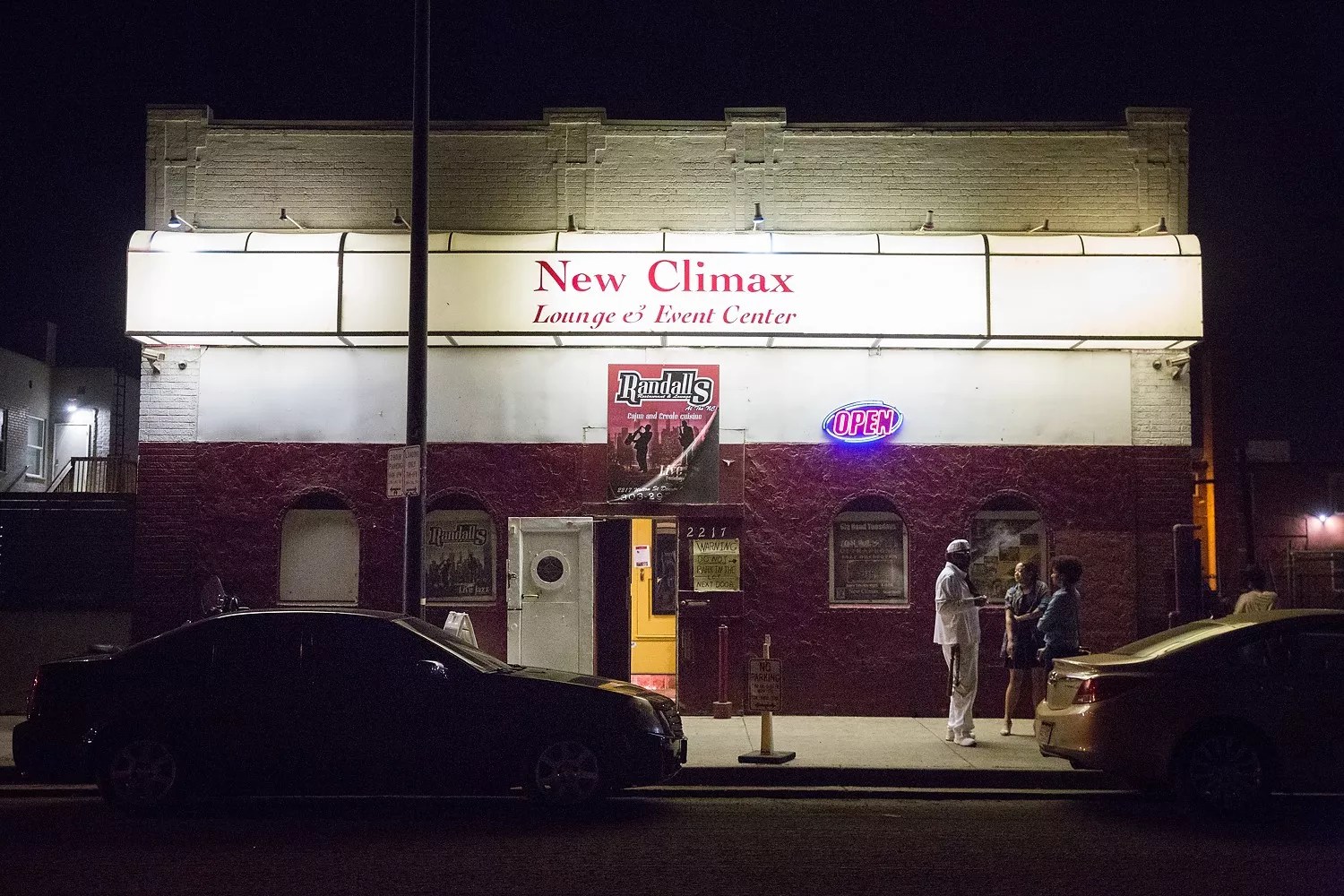
Outside Randall’s at the New Climax on a Friday night.
Danielle Lirette
This windowless lounge sits behind a crumbling facade that’s hung with a banner announcing the presence of Randall’s; you enter through a scrappy-looking screen door with a sign warning patrons against parking in the attached lot. Come on a Friday evening and you’ll find crowds so friendly they might be at a family reunion, chatting and drinking before making their way through a buffet line of steam trays, piling plates high with Creole and Cajun food, then grabbing seats before the music starts. On a weekday afternoon, some of those same people will fold themselves into booths along the perimeter and order fried catfish, po’boys and chicken wings, then linger over empty plates until they have a chance to chat with Borne, who likes to post up at a corner of the bar, assuming he’s not cooking or bartending.
“It’s about good-priced food and drinks,” Borne says of his enterprise. “I’ve never been in it to get rich, and I would never get rich. I just try to make a place for people to come, gather and have a good time.”
The building was owned by Albert Bryant for more than four decades and saw stints as an after-hours venue, then a punk-rock club called the Raven before becoming an indie-rock performance space named the Climax. When Bryant brought in a nephew to run the place, he rechristened it the New Climax and gave it more of an R&B vibe. Borne became a tenant three years ago, tacking his name onto the moniker and vowing never to host hip-hop performers and to keep the good food and the blues coming.
But all that may be coming to an end. After Bryant passed away, the New Climax building was sold last year. Borne recently learned that he has to be out at the end of July, leaving him to scramble for another space.
Again.

Welton Street back in 1978.
Thomas J. Noel/Denver Public Library
The youngest of sixteen children, Borne grew up in Edgard, Louisiana, about 25 miles west of New Orleans. When he was thirteen, his parents sent him to live with an older brother, Paul, who resided in the Five Points neighborhood of Denver. “I followed in his footsteps,” says Borne. “Everyone knew Paul. His dream was to open a bar, so I did that.”
After attending Manual High School and then Southern University in Baton Rouge, Borne returned to Denver briefly to work in a furniture store and then went into the electronics industry in Memphis. He worked his way up at Intelligent Electronics – then under the executive leadership of Apple’s Tim Cook – until he ran a team of twenty people. He was frequently cooking, though, and his food became so popular with friends, they started hiring him for catering jobs.
Intelligent Electronics moved Borne back to Denver in 1989, and he became interested in a mobile food vendor that was always stationed outside one of the company’s warehouses. Borne ran into the operation’s owner at the airport one day and learned he was getting out of the business. “He built my first trailer,” Borne recalls, and he also left him with a prime patch of real estate at 48th Avenue and Dahlia Street. Borne quit his job and began cooking and selling Creole and Cajun food full-time.
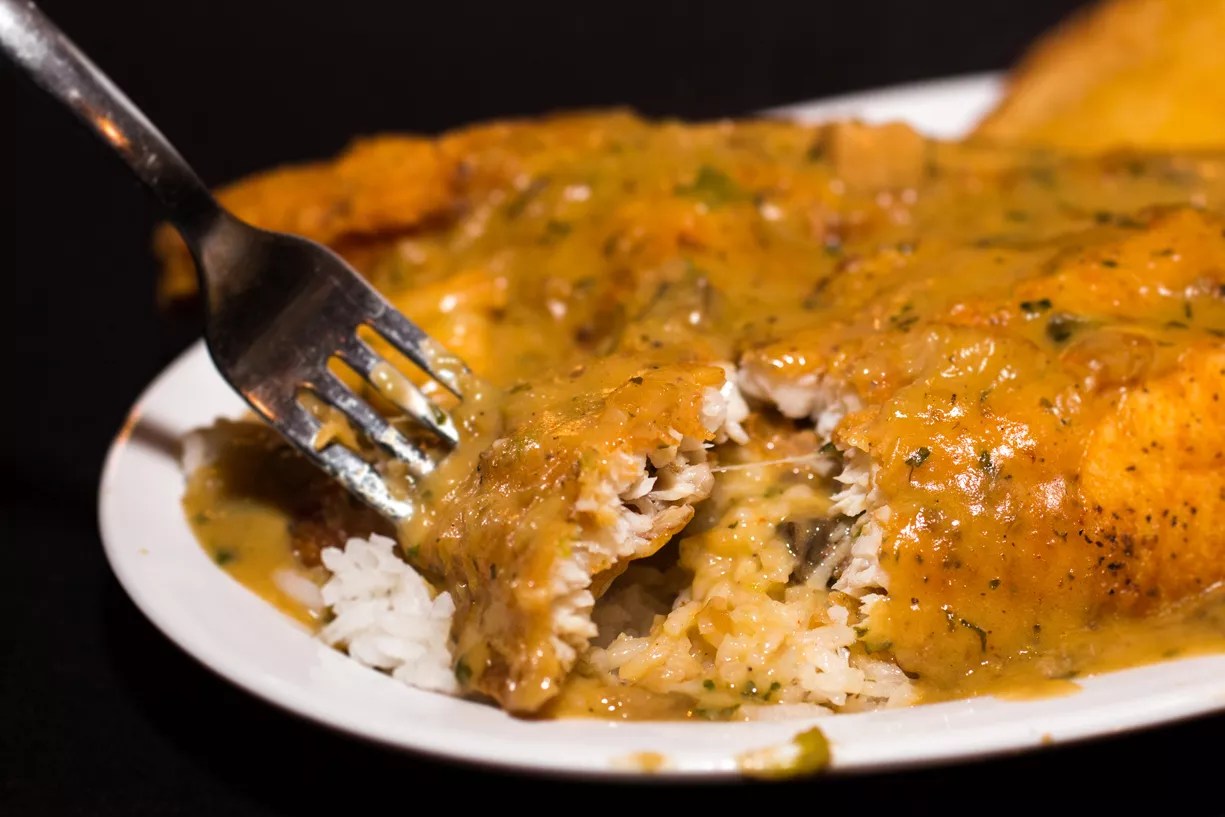
Randall Borne’s smothered catfish.
Danielle Lirette
The mobile cart grew into a successful catering operation, which Borne ran for nearly fifteen years. Then in 2007, he fulfilled his brother’s dream when he picked up the lease for Marion’s Lounge at 4042 York Street, where he continued to build a following for his food and also added a bar. “It was a smaller place with less headaches,” he says.
Two and a half years later, after light-rail construction swallowed that business, Borne got the opportunity to revive the legendary Pierre’s Supper Club at 2157 Downing Street, an establishment that was once an exalted soul-food restaurant and nightlife destination, bringing in everyone from famous musicians like Willie Nelson and Gladys Knight to Bill and Hillary Clinton. “I was flying from New Orleans once, and I was on the plane with a politician from South Carolina,” remembers Borne. “We were sitting together, and he asked, ‘Where are you from?’ I said, ‘New Orleans, but I live in Denver.’ And he said, ‘Oh, man, we used to go to this place in Denver called Pierre’s Supper Club.’ And I said, ‘I run that place!’ Mr. Pierre was a legend.”
He was also an uncle of Borne’s who’d opened Pierre’s in 1962 and owned the building for 35 years before selling it in the early 2000s. Borne leased it from the new owner after a few other clubs had failed, and tried to channel the spirit of the original Pierre’s, naming his spot Randall’s at Pierre’s. “It was so different from the first place I was in,” he says. “Pierre’s had a bar upstairs and downstairs. You could have three or four parties there.”
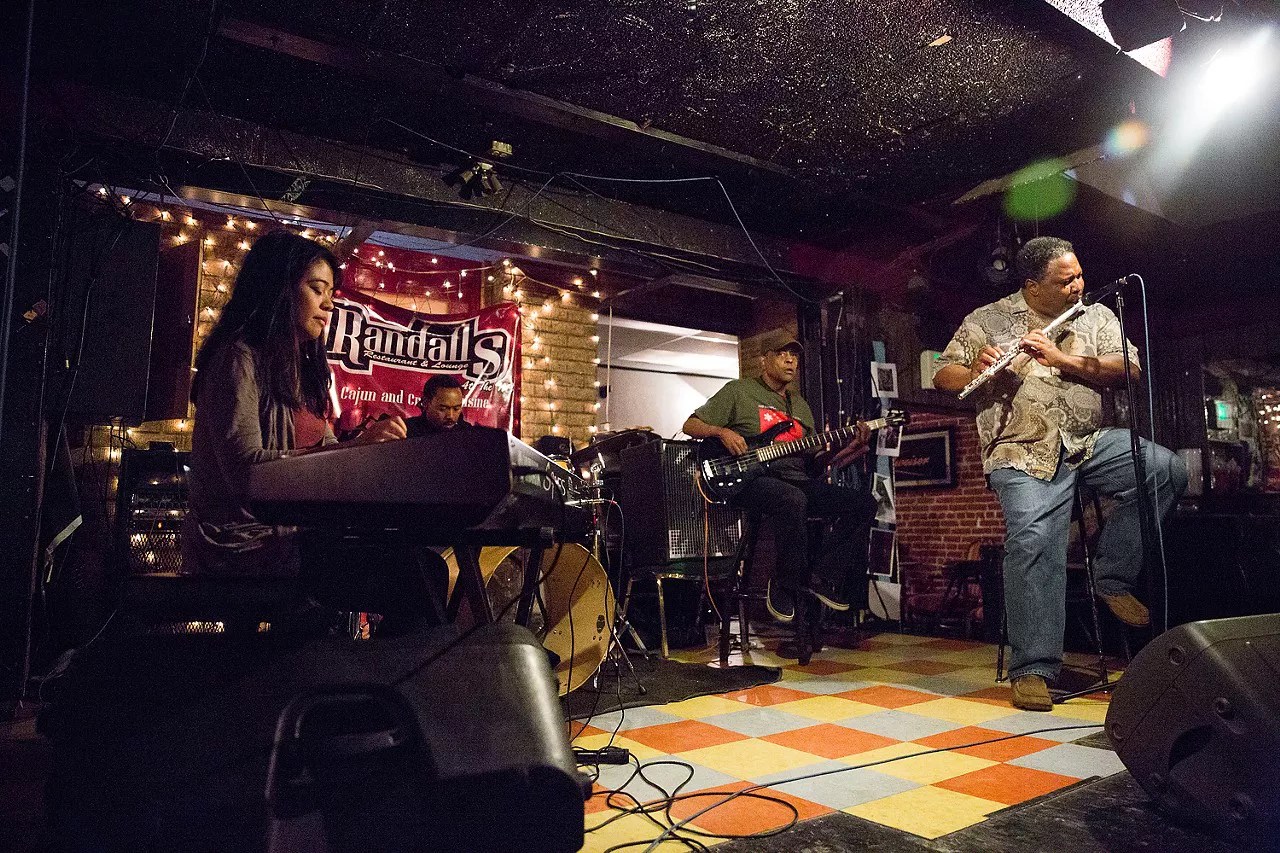
Randall
Danielle Lirette
And he often did. It was at Pierre’s that Borne really captured his loyal following, extending his base with regulars who’d been patrons of Pierre’s back in the day. And he took his community commitment seriously, opening his establishment to the homeless for a meal and football every Thanksgiving. But he could see that the community was changing. Property values were rising and more affluent families were moving into Five Points, buying up houses from longtime residents (or their kids, after their parents passed away), who were dispersing to the suburbs. “I can’t blame them. If someone offers you ridiculous money for a property you bought for $70,000, you’re going to take it,” says Borne. “But it’s sad to see this happening, and it’s happening all over the country.”
It happened to Borne, too: Five years into his run at Pierre’s, he learned the building had been sold – and he had to clear out so that it could be razed for a new townhome development. “It was real sad to see the Pierre’s building go down the way that it did,” he laments. “It should have been a landmark.”
“There’s no place for the black community to go. We have more than friendships. We’re kind of like family. “
Borne looked around for a new spot in the neighborhood and found it at the New Climax three years ago, after a project in the 2700 block of Welton fell apart. “The reason I continue is for my customers – people ask me to,” he explains. “There’s no place for the black community to go. We have more than friendships. We’re kind of like family. They have a place to come kick it and enjoy themselves.”
Councilman Albus Brooks, who represents Five Points and is now a regular customer at Randall’s, agrees: “African-Americans from all over the metro area go to his location because they feel like it’s home.”
“Randall is an anchor,” adds Norman Harris III, who grew up working at his grandfather’s liquor store in Five Points and is a partner in the recently announced refurbishment of the Rossonian Hotel, just up the street from Randall’s at 2650 Welton.
At the Climax Lounge, Borne inherited a booth-lined dining room, a stage and a jazz orchestra that he was happy to keep coming every first and third Tuesday of the month. He brought in his own Cajun and Creole cooking, as well as his commitment to the community, making sandwiches to distribute at the Denver Rescue Mission and hosting a yearly fundraiser for Manual High School.
Now that he knows he’ll have to move again, he feels that staying in Five Points is more imperative than ever. That way, he can keep the legacy of Welton Street alive. “It’s crazy to let all the history go,” he says. “You’re going to still get people who come into town who want to see Five Points, and they’re going to be shocked to see it like this. It ain’t that some of it’s changed; everything has changed. The mayor, councilman [Brooks] and politicians in this area can do something about that to keep some of the history, to say, ‘Hey, this is still part of the Five Points neighborhood.'”
Five Points and adjoining Whittier were the first neighborhoods to extend beyond the bounds of Denver’s original grant from Congress; they emerged during the silver boom of the late nineteenth century and were connected to downtown by a streetcar. From the start, African-Americans were drawn to the area; according to the Denver Public Library, during the 1870s, a stretch of 22nd Street was referred to as the “Deep South” to reflect the community of black railroad workers from Georgia who’d settled there. The first African-American congregation in Colorado worshipped at the Zion Baptist Church, established in 1865.
By the 1890s, the majority of Denver’s African-American residents lived in the area, and that population continued to grow. In the ’20s, as the city’s moneyed set moved to Capitol Hill, an estimated 90 percent of the city’s African-American community resided in Five Points, having been excluded from other neighborhoods.
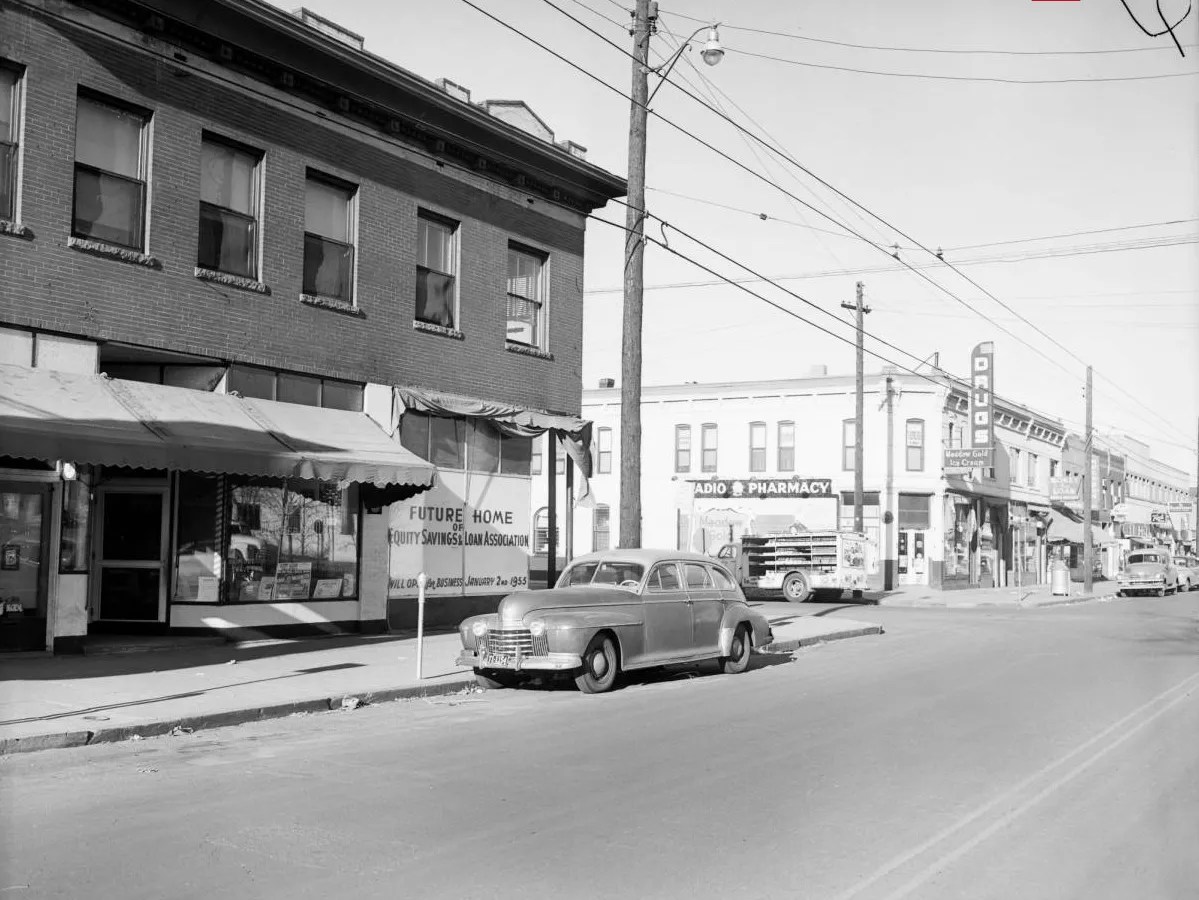
Five Points when it was the “Harlem of the West.”
Denver Public Library
In the following decades, Five Points became such a destination for jazz and entertainment, it was dubbed the “Harlem of the West.” Much of that reputation centered around the Rossonian, built a century ago. “The Rossonian is the crown jewel of Five Points,” Harris explains. “Historically, it was a hotel for African-Americans who’d perform for white crowds downtown but weren’t allowed to stay in those hotels. So they’d perform those shows and then come do these late shows at the Rossonian, where they stayed. That created this captivating culture incubated in Five Points. I’ve got old pictures of people in the Rossonian, dressed up, smiling – it was the place to be.”
The Rossonian hosted most of the big names of its era: Duke Ellington, Ella Fitzgerald, Nat King Cole. And thanks to its influence, other music venues and nightclubs popped up along Welton Street, drawing top talent from the coasts. Jack Kerouac immortalized that era in On the Road:
“At lilac evening I walked with every muscle aching among the lights of 27th and Welton in the Denver colored section, wishing I were a Negro, feeling that the best the white world had offered was not enough ecstasy for me, not enough life, joy, kicks, darkness, music, not enough night… I wished I were a Denver Mexican, or even a poor overworked Jap, anything but what I was so drearily, a ‘white man’ disillusioned.”
“At lilac evening I walked with every muscle aching among the lights of 27th and Welton in the Denver colored section, wishing I were a Negro…”
Despite its reputation, “Five Points has never actually been all black,” Brooks notes. “It’s always been a very inclusive neighborhood.” Many third-generation Hispanic families still live in the area; during World War II, it hosted a Japanese enclave.
After those halcyon days of the mid-century, though, the neighborhood began to empty out, and African-Americans moved to new neighborhoods like Park Hill, one of the first in the country to integrate, reducing the population of Five Points by 75 percent between the end of the ’50s and the mid-1970s. In 1980, Harris’s grandfather circumvented discriminatory lending rules in Denver by obtaining a federal HUD grant and developed a building for low-income housing in the 2600 block of Welton for community members and veterans.
The Rossonian had been shuttered for years by the time Harris started working in his grandfather’s business in the late ’80s. Not only had Five Points lost its major draw, but it had lost its legendary reputation. “There was a time when if you lived west of Downing, people thought you were trash,” he remembers. “It was not a prestigious thing. When I was at school, kids were referencing Five Points with a negative connotation.”
But still, he says, African-American-owned businesses continued to define the place and keep it going. “When I was in high school, I went to parties at the Roxy and Casino, which is now Cervantes’. The restaurants Capri and Tosh’s Hacienda were staples. You could run down the street and find several places to eat.” And just a few blocks away, Pierre’s, which had opened in 1962, was still on a roll.
“Five Points has had a significant role in and impact on many things I’ve done,” Harris says. “Those are the stories I’m carrying with me to make sure they live on.”
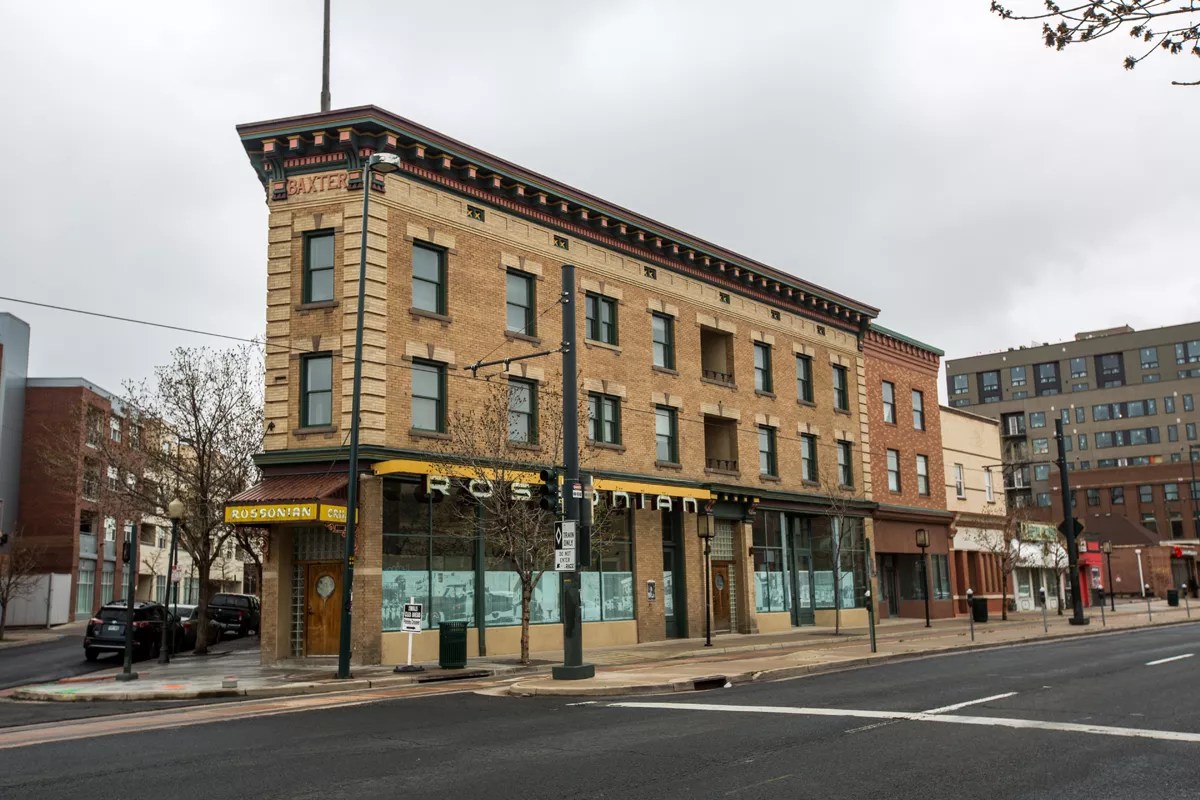
The Rossonian is sltated to make a comeback.
Denver Public Library
When he was first running for Denver City Council seven years ago, Brooks says, residents were less concerned about the ethnic makeup of Five Points – and the prospect that groups who’d long lived there might be displaced – than they were about the neighborhood’s revival. “When I was knocking on doors in 2011, African-Americans, white folks, everyone was saying, ‘If you don’t help Five Points revitalize, what are you doing?'”
Denver’s first light-rail route, completed in 1994, ended in Five Points, where it was supposed to revitalize the area. It didn’t. Five Points was named the city’s first historic cultural district in 2002, a move that was supposed to do the same. It didn’t.
Brooks didn’t know it in 2011, but revitalization was about to come, and fast. “Little did I know we’d be in the largest economic cycle of Denver’s history,” he says. “It became harder to maintain the character of African-American ownership.”
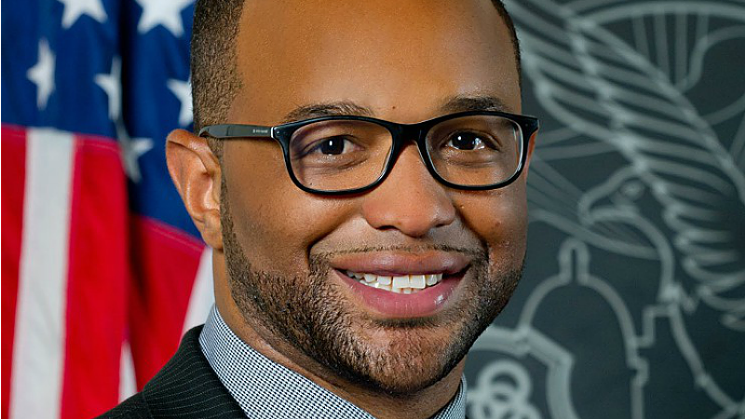
Denver City Council president Albus Brooks.
Denver City Council
Many of Denver’s urban neighborhoods exploded over the last decade; a report by the Downtown Denver Partnership estimates that the Five Points population surged by 26 percent between 2010 and 2017, and the pace of construction in the area matched that of RiNo and Highland. That pace hasn’t slowed yet in Five Points.
“In 2009 and 2010, I had plans for my grandfather’s building,” recalls Harris. “I was trying to understand how to do a real estate deal, and no one understood that value. Now, some of those same people are down there kicking on doors to try to buy something – but it’s six, seven, eight years late.”
Borne says he’s watched people flee the neighborhood – the lucky ones with a pocket full of cash after selling, the less lucky because they can no longer pay the rent. “You can’t afford an apartment here,” he says. “A one-bedroom goes for $1,400. Folks that have better jobs – folks moving from out of town – are used to paying high rent, so this looks like a bargain. But it’s not to the people who’ve been here.”
“The challenge with Five Points right now is that we don’t see the number of African-American-owned businesses.”
Borne finds it especially troubling that African-American-owned businesses have gone under despite the rise in population and property values. “I knew the lady who owned the flower shop at 21st and York three or four years ago,” he says. “She never got the neighborhood business from gentrification like she should have. That’s wrong. It’s crazy. And you see that a lot.”
Harris sees the problem. “There’s still a high percentage of African-American property ownership,” he notes. “The challenge with Five Points right now is that we don’t see the number of African-American-owned businesses.
“The changes are bittersweet,” he adds. “There has been a ton that’s been lost. There’s a ton of culture – the components that really made Five Points the neighborhood what it was – that I don’t think will ever return.”

Welton Street at night.
Danielle Lirette
The city has made some attempts to stem the displacement. “Of the 20,000 deed-restricted properties in the city, 5,000 are in Five Points,” says Brooks. “But we’ve gotta do better.” He sees the shrinking of African-American business ownership, which has gone down to 50 percent on Welton Street from 65 percent a few years ago.
But Brooks also believes that “preservation and revitalization can co-exist.”
And Harris agrees: “Change happens. We need to be the authors of it, not the victims of it.”
To make that happen, Harris has thrown himself into a number of initiatives: He’s the executive director of the Juneteenth Festival, an annual celebration of emancipation that’s been a draw in Five Points since the mid-’60s; he’s parlayed that into a partnership with event firm Two Parts, adding a food truck festival. He’s also a partner with developer Paul Books and Palisade Partners in the Rossonian revival, which he sees as an inclusive community anchor.

Inside Randall’s on a Friday night.
Danielle Lirette
“The Rossonian is a dream come true for me to be a part of,” he says. “In my opinion, it’s the most valuable piece of property in Five Points. What makes me very excited about it is that everyone involved understands the significance of making sure everything that happens is done right and that it’s as inclusive as possible.” In addition to reopening the Rossonian as a hotel, the group has announced that Denver Nugget Chauncey Billups will bring a restaurant to the space.
According to Brooks, because the heart of Welton Street has protected-landmark status, and because the city is investing in the neighborhood, Denver City Council, the Office of Economic Development and the Five Points Business District have tools at their disposal to help shape what the neighborhood should be. “We’re unapologetic about looking for African-American owners,” Brooks says.
“Five Points will always be the epicenter of black culture in Denver,” adds Harris. “No one can erase that history; it’s in the bricks. But it’s also the responsibility of me and everyone in the city to make sure our legacy lives on. We need to make intentional efforts to keep the stories alive. The big, overriding question is, how do we bring people back and make it inclusive for everyone?”

Inside Randall
Danielle Lirette
And is there still a place for Randall’s in Five Points?
“I want him to be on Welton in historic Five Points,” says Brooks. “We’re working with OED for funding, and I believe we’ve identified it to help with transition and improvements. We’re excited and hopeful that we can solidify Randall’s for the next five to ten years.”
“I’m advocating so much for Randall,” says Harris. “He’s a really good friend. There are people within the Five Points Business District who understand the value of Randall’s. We have to find a solution. There are more than enough people down there that can help facilitate that.”
Borne knows he may need to scale back; he’s ready to get out of nightclubs and instead focus on his restaurant and bar business. While he looks for a spot where he can do that, a nephew is reviving his uncle’s catering business and will soon start slinging the restaurant’s recipes from a mobile kitchen that he plans to haul all over town.
But right now, Borne is making plans for a final bash at the New Climax. Before the place closes, he wants to host a days-long party. He’s going to invite all of the bands that have performed at any of his establishments.
He’s going to show everyone in Denver what this city can’t afford to lose. “I really think the city – the mayor – should step up and make sure we have a place in the community,” Borne concludes. “An affordable place in the community to hang out.”
Go to westword.com/music for a slideshow of Randall’s at the New Climax on a Friday night, westword.com/restaurants for more on Randall Borne’s kitchen.